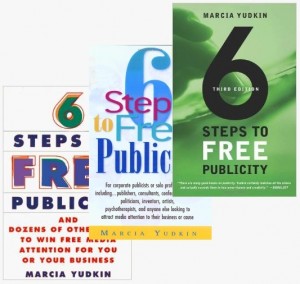By Marcia Yudkin
To celebrate the milestone of my book 6 Steps to Free Publicity remaining in print 20 years after its first edition appeared, here is the second part of my post about 20 points about publicity that are as true now as in 1994. You can catch up on Part 1 here.

- Media coverage impresses people on planes and at parties.
6 Steps begins with me on a flight to the west coast sitting beside a Congressman who gave me a look of respect when our other seatmate told him my company was on page 1 of the Wall Street Journal that morning. While I have been in situations over the years where snobby people scoffed “So what?” at various achievements of mine that I rather cherished, this has never happened with the Wall Street Journal story or my cover story for Psychology Today being mentioned by Tom Brokaw on the national nightly news.
- Errors may happen.
Human nature hasn’t changed. Both reporting and editing involve fallible human beings who can make mistakes in spelling, facts or interpretation even when they’re putting in their best professional effort. In some contexts, though, it’s easier than 20 years ago to get corrections into the public record for posterity. Reputable news organizations usually post corrections online along with their original story, whereas in the past the corrections would appear in a different issue, with the original mistake left as is.
- Publicity benefits causes.
Whether it’s someone in the community who needs a new wheelchair van, activists trying to kill a proposed new law, or a nonprofit spreading awareness about the dangers of chemical lawn fertilizers, articles, letters to the editor and on-air interviews definitely get you closer to the goal. In the 1980s, I got two local TV stations to cover a Mother’s Day march for peace that I helped organize by emphasizing in my press release that the event would feature colorful banners and kids holding balloons. Thinking visually and dramatically today still helps get your advocacy message out.
- Publicity can change minds.
In 6 Steps I discussed the power of publicity to challenge stereotypes. Last year the toy company GoldieBlox released a video parody of the lyrics from the Beastie Boys’ “Girls/To do my dishes/Girls/To clean up my room,” with young girls singing instead “Girls/To build a spaceship/Girls/To code the new app” with such joy that it was hard not to see them as future engineers. Before the video was pulled from YouTube because it infringed on the Beastie Boys’ copyright, 7.5 million visitors saw it, and millions more were exposed to its idea from coverage of the story.
- Schmoozing with media folks is smart.
Over the years, I have featured scores of subscribers to my Marketing Minute newsletter in that publication after they sent me spontaneous email comments and I wrote back to learn more about their point of view or success story. Of course, it’s even smarter if you’re deliberate yet still informal in your schmoozing, as I recommended in 6 Steps. Today you can schmooze by following reporters, columnists or popular commentators on Twitter, post comments in response to their content or upload a video review of their latest book to Amazon.
- Published articles by you attract attention from key prospects.
An article I published several years ago in a magazine for financial advisors led to copywriting projects with clients in that industry for the next three years. More recently, a guest blog post brought me thousands of dollars’ worth of immediate registrations in an upcoming coaching program. It’s the very same dynamic.
- Speaking elevates you to expert status.
As I explained in 6 Steps, by virtue of being the one listed on the program and standing in front of the room, you’re credible to your audience. In addition, being a speaker creates powerful opportunities for pre-event, post-event and word-of-mouth publicity. These truths have not faded in the slightest since the first edition of my book.
- Publicity can cost nothing but time and energy (and perhaps some trifling expenses).
To get featured on page 1 of the Wall Street Journal in 1990, I paid for copying and stamps to 100 or so top media targets. Today a creative, well-timed email or tweet that costs you nothing can get your message into newsrooms across the country or around the world. If you understand the way the media work, you still do not need to hire a designer, copywriter or professional publicist to get your message out.
- You can invent and publicize a holiday.
Chase’s Calendar of Events continues to come out annually, listing events sponsored by organizations, like World Oceans Day and Elvis Week in Memphis, but also special days proposed by individuals, such as National Columnists’ Day, created by Jim Six of Woodbury, N.J. and International Aura Awareness Day, from Cynthia Larson of Berkeley, Calif. The cost to get listed in Chase’s? Still zero.
- Publicity is fun.
Compared to, let’s say, preparing financial projections, firing a client or writing up performance reviews, strategizing ways to get publicity is energizing and enjoyable. You get the chance to exercise your playful, imaginative capacities. Studying what others have done to earn publicity is mind-expanding and delightful as well. Twenty years after first publishing my advice on publicity, I still consider this vehicle for spreading the word a treat to plan and its results particularly gratifying. How about you?
I welcome your reflections and anecdotes on publicity constants—and changes—in the Comments.